|
Brushfoots
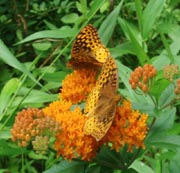
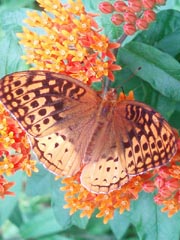
Great
Spangled Fritillary (Speyeria
cybele ): The most common Fritillary in the east. The
upper specimen is probably an older female. Lower specimen
is a young male. Location: Blue Ridge Center for
Environmental Stewardship, VA.
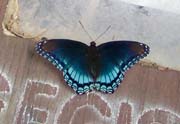
Red Spotted Purple (Limenitis
arthemis astyanax): This is a mimic of the poisonous
Pipevine Swallowtail. Readily hybridizes with the
sub-species White Admiral below to form several ntermediate
"proserpina" types. Location: Pine Lick Trail and Fifteen Mile
Creek Rd, Green Ridge State Forest, MD.
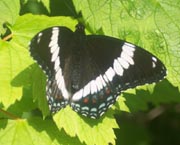
White Admiral
(Limenitis
arthemis
arthemis) Readily hybridizes with the sub-species Red
Spotted Purple above to form several ntermediate "proserpina"
types. Photo by Jeff Mitchell.
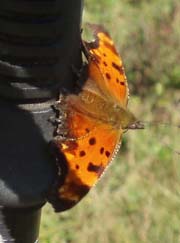
This Eastern
Comma Butterfly (Polygonia comma) must be attracted
to the salt on the handle of this trekking pole. Note
the orange hindwings; in summer they are black. Location:
Dobbin Grade Tr, Dolly Sods North, WV |
Brushfoots (con't)
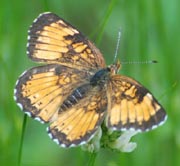
Northern
Crescent (Phyciodes cocyta): 1 7/8 inches max. A more
northern species that, oddly, has a large distribution in WV
and a narrow band through PA, roughly following the
Allegheny Mountains. Very similar to P. tharos - the Pearl
(below)
Crescent which is much more common in our region. Top photo by
Anita Mueller.
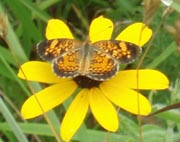
Pearl
Crescent (Phyciodes tharos): Very similar to
P. cocyta (above). This one is more common to our region.
Location:
Blue Ridge
Center for Environmental Stewardship, VA.
 
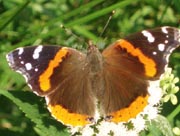
Red
Admiral (Vanessa atalanta): a 2" Brushfoot.
Migratory. Location: Overall Run, SNP, VA and McCray Tr,
MNF, WV.
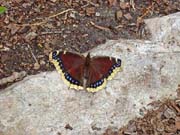
Mourning
Cloak, Nymphalis antiopa,
One of the first butterflies to set flight in spring.
Location: Little Passage Creek, Massanutten Mt, GWNF, VA. Photo by Tony Van Vugt.
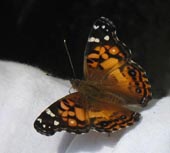
Painted Lady (Vanessa
cardui): A small ( 2" max) migratory brushfoot
butterfly. Location: Black Forest Tr, PA. Photo by Betty
Steil. |
Brushfoots (con't)
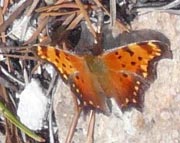
Gray Comma (Polygonia
progne): Similar to the Eastern Comma below but with
more pronounced light spots along its wing edges. Location:
Halfmoon Lookout, WV. Photo by Craig Ross.
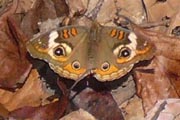
Common Buckeye
(Junonia coenia): Only 2.25 inches. An extra set of
hindwing eyes are hidden by the forewings in this shot.
Location: Little Stony Creek Tr, GWNF, VA. Photo by Craig
Ross.
Swallowtails
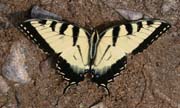
Tiger
Swallowtail Butterfly (Papilio
glaucas): Photo by Ken Clark.
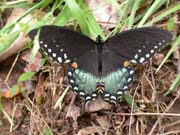
Spicebush
Swallowtail (Papilio
troilus): Photo by Ken Clark.
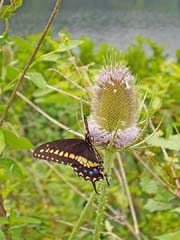
Black Swallow Tail, Papilio
polyxenes, on Pickerel Weed: Double row of yellow
spots sets it off from similar species. Location: GRT
Wildlife Refuge, VA. Photo by Tony Van Vugt.
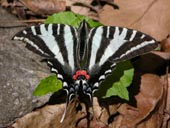
Zebra
Swallowtail (Eurytides
marcellus ): Location - Harpers Ferry, WV. Photo by
Ken Clark.
|
Hairstreaks/Blues
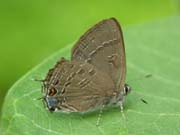
Banded
Hairstreak (Satyrium
calanus): Found on Milkweed along Waites Run,
Great North Mountain, GWNF, WV. Photo by Ken Clark.
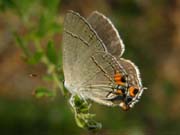
A
"Northern" Southern Hairstreak (Fixsenia favonius
ontario) - Location: Cape Henlopen SP, DE. Photo by
Ken Clark.
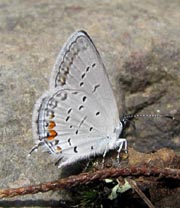 ] ]
Eastern
tailed-Blue (Everes comyntas): Prefers sunny,
weedy environments. Photo by Ken Clark.
Whites and
Sulphurs

Cabbage
White (Pieris rapae): 1.75 inches. One of the
most common butterflies in our region. Caterpillars can
cause economic damage to cabbage, broccoli and collards
crops. Males have one black spot. Females have two. on
each forewing. Tip of forewing is black on top and
yellow underneath.
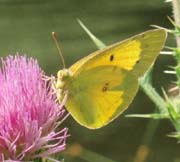
Clouded
Sulfur (Colias philodice): 2 - 2.75 inches.
Upperside is bright yellow with black margins. Underside
lighter with a spot on the forewing, a pink bull's eye
on the hindwing and Some slight marginal black markings.
Feeds on legumes and clovers. Found in open fields.
|
Satyrs/Milweed
Butterflies
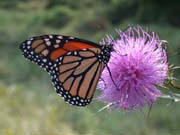

Monarch
Butterfly (Danaus plexippus):
Some Monarchs are toxic to predatory birds because of the
juices from certain milkweed that they consume. Their orange
color signals a warning to birds to leave them alone. Other
orange butterflies are often called "mimics" because it is
thought this color causes birds to also leave them alone
even though they are not toxic. Photo by Ken Clark taken at
the Howard County Conservancy, Woodstock, MD. Caterpillar
was found on the Roaring Plains, MNF, WV. Photo by Eric
Shereda.
Skippers
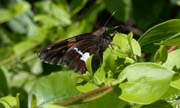
Silver-spotted Skipper (Hesperia
comma): Photo by Ken Clark.
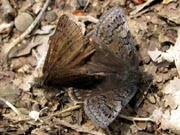
Sleepy
Duskywing (Erynnis brizo): Up to 1.75 inches. Often
found on ridge tops in areas of scrub oak or cut over oak
forests. Photo by Ken Clark.
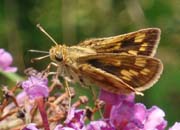
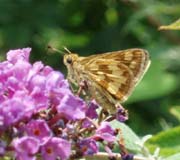
Peck's
Skipper (Polites
peckius):
7/8". Underwings brown with orange patches. Food plants
grasses.
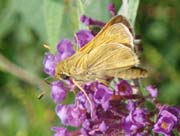
Least Skipper (Ancyloxypha
numitor): 3/4". Underwings yellow-orange. Top of
hindwings orange with wide dark margin. Marshes, ponds moist
meadows. Feeds on grasses. |

